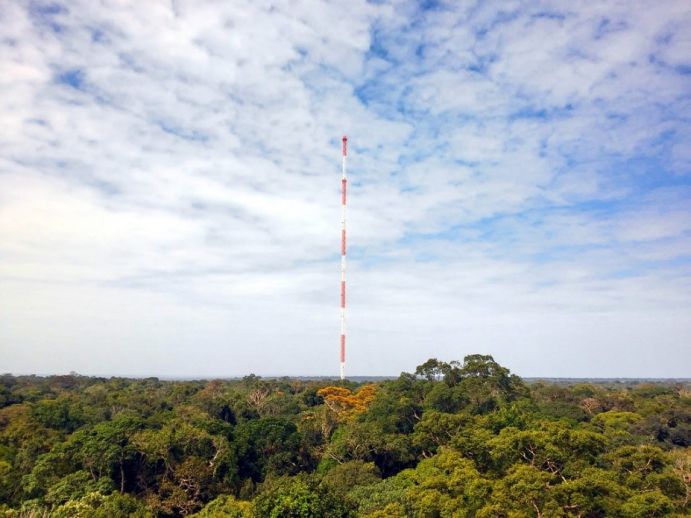The ATTO tower at the heart of the Amazon rainforest celebrates its fifth birthday
The 325-metre-high tower was inaugurated on 15 August 2015 and is at the core of the BMBF-funded Amazon Tall Tower Observatory (ATTO) research infrastructure. Here, research is conducted into the effect of the Amazon rainforest on the global climate.
The Amazon Tall Tower Observatory is located in the middle of the Amazon basin of Brazil, about 150 km northeast of Manaus. In this remote region, scientists from German and Brazilian research institutions have been jointly studying the interactions between the rainforest and the atmosphere for ten years. At the heart of the research station is a 325-metre-high steel tower. Measuring approximately the same height as the Eifel tower in Paris, the ATTO tall tower is the highest research tower in South America and extends far above the forest canopy. It will celebrate its fifth anniversary on 15 August.
The scientists at the Max Planck Institutes for Chemistry in Mainz and for Biogeochemistry in Jena have long been aware of the importance of the Amazonian rainforest for the global climate, but they lacked continuous long-term measurements accurate enough to be linked to global networks of climate and atmospheric research such as ICOS or IAGOS. In 2010, the researchers set up the first infrastructure in cooperation with the National Institute of Amazonian Research (INPA) in Manaus. An 80-metre-high tower and a mast of the same height were built and used to carry out the first atmospheric measurements. They form the basis for the continuous and long-term observation of the climate in the Amazon rainforest.
Since then, the German-Brazilian research station has grown steadily. More than 200 researchers from universities and research institutions from across the world are involved: biologists, ecologists, meteorologists, chemists and atmospheric physicists work on complex, climate-relevant issues in an interdisciplinary way. New instruments are specially being developed, adapted and optimised for use under the harsh climatic conditions of the tropical rainforest. Some studies provide information about local biological and climatological processes in the rainforest and the atmosphere, which are influenced – amongst other things - by the composition of plant species and geographical conditions.
For five years now, the ATTO tall tower has enabled researchers to collect atmospheric data at an altitude of more than 300 metres. With a measuring range of several hundred square kilometres, ATTO covers a large part of the Amazon basin and thus the largest still relatively homogeneous forest area in the world. This area represents one of the most important regions for the global climate system and is strongly affected by current and future climate and land use changes.
One discovery made by the scientists working at ATTO is that 60 % of the rain that falls over the Amazon re-enters the atmosphere. This is largely due to the transpiration of plants, especially large trees. For new clouds to continuously form, so-called condensation nuclei (aerosols) are needed. During the rainy season, the air above the Amazon is so clean that it barely contains any aerosols such as pollutants. Instead, organic gases released by the forest itself play a major role: through chemical reactions, particles are produced in the atmosphere which contribute to cloud formation and precipitation. These gases also include volatile organic compounds (VOC). Although the Amazon rainforest covers only four percent of global land surface, 25-40 % of all global VOC emissions come from the Amazon rainforest.
ATTO is a unique scientific platform for long-term research which enables a better understanding of the role of the Amazon in the Earth system. The use of ATTO will close major knowledge gaps in the tropics by providing research infrastructure data sets for the validation of climate models and satellite observations and by providing new insights for the improvement of global carbon cycle and climate models.
Background
The research infrastructure "Amazon Tall Tower Observatory" (ATTO) is a German-Brazilian cooperation project. It is led by the Max Planck Institutes for Biogeochemistry in Jena and for Chemistry in Mainz, as well as by the Brazilian INPA and the Amazon State University (UEA) in Manaus. The project is funded by the German Federal Ministry of Education and Research (BMBF), the Brazilian Ministry of Science, Technology and Innovation (MCTIC), the Max Planck Society, Brazilian organizations such as FAPEAM and individual scientists who contribute research funds from other organizations.
BMBF has been funding ATTO since 2010 with a total of 9.1 million euros to date. The ATTO tall tower, which is over 325 metres high, was inaugurated on 15 August 2015.




